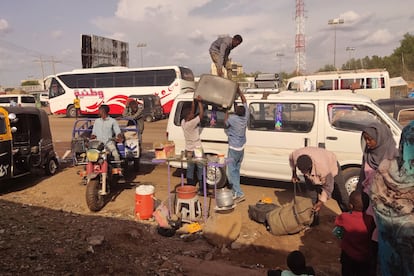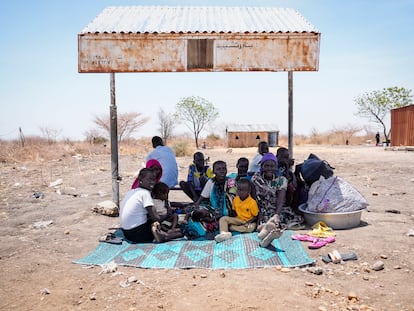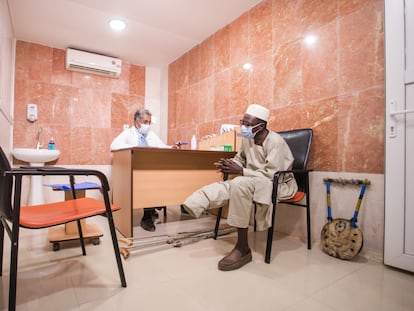War in Sudan returns Darfur region to hell
The conflict-plagued western region of Sudan is, once again, the scene of numerous atrocities. While fighting between the Army and paramilitary forces continues in the capital of Khartoum, violence is also spreading to other parts of the African country

Some of the worst omens for Sudan began to come to fruition when a power struggle broke out in April, between the Sudanese Armed Forces and the paramilitary Rapid Support Forces. After two-and-a-half months of war – and after several failed mediation attempts – the conflict is entering a critical phase, marked by an alarming escalation of violence and the opening of new fronts. All of this is aggravating the humanitarian crisis in the country, while fostering the proliferation of serious human rights violations.
The most rapid deterioration is taking place in the western region of Darfur – a traditional stronghold of the Rapid Support Forces. There, both the military and the police have withdrawn from many cities and towns, leaving large power vacuums in their wake. This has paved the way for the deployment of paramilitaries and other Arab militias. Both are spreading terror across this part of Sudanese territory, while blocking humanitarian corridors and the arrival of foreign aid – actions that they deny.
The worst episodes of violence are being documented in el-Geneina, the capital of West Darfur. Attacks by paramilitary groups and Arab militias in the city – which, in recent years, has been the scene of massacres – have a marked ethnic character against people from non-Arab groups, who have armed themselves in an attempt to stop the assaults. Several local and regional human rights groups estimate that the attacks have left more than 1,000 dead in el-Geneina alone.
Since mid-May, communication and internet services in el-Geneina have been frequently interrupted, making it difficult to determine the magnitude of what’s actually happening. But the massacres coincide with a widespread shortage of food and water, as well as the collapse of basic services, such as health care. There are also reports of sexual violence and targeted killings of community leaders and activists.
Doctors Without Borders (MSF) has observed that the escape route to Chad – just 12 miles away – is “fraught with dangers,” especially due to the presence of armed groups. MSF has pointed out that hundreds of people have been shot and killed while trying to flee. Rapes have also occurred. Despite these risks, some 117,000 residents of Darfur – the majority from el-Geneina – have fled to the neighboring country since the start of the war. Meanwhile, according to UN data, almost 300,000 have been internally displaced.
The situation in the city bottomed out in mid-June, when the governor of West Darfur – Jamis Abdallah Abkar, who hails from a non-Arab tribe – was assassinated after giving an interview to Saudi television. In the interview, Abkar described what’s occuring in the region as a genocide, blamed the Rapid Support Forces – and related Arab militias – for the violence and called for the international community to intervene.
In a conversation with EL PAÍS, a spokesman for the Rapid Support Forces denies that they are behind the events in question, affirming that they have evidence that incriminates the Army (although he doesn’t offer any). In a verified video of the moment of Abkar’s arrest – which has been broadcast on social media – men in paramilitary uniforms and one of their commanders can be seen in the shot. The spokesman says that they were protecting the governor.
Alice Wairimu – the UN special adviser on the prevention of genocide – has described the violence in Western Darfur as “appalling,” while also warning that it could lead to “new campaigns of rape, murder and ethnic cleansing.” A union of doctors in the region has compared the situation in el-Geneina to the Rwandan genocide of 1994.
Beyond el-Geneina, in recent weeks, there has been an uptick in violence in the rest of the states in the Darfur region. Some of the hardest hit places include the city of Kutum – which has been declared a humanitarian disaster area by the North Darfur government – and displacement camps in the same state. Zalingei and Nyala – the capitals of Central Darfur and South Darfur respectively – have also been the scenes of heavy fighting.
In the early-2000s, Darfur already suffered a ferocious offensive and campaign of ethnic cleansing led by militias that, today, largely make up the Rapid Support Forces. Former dictator Omar Al Bashir used these groups to quell an armed uprising, which had revolted against the repression, sectarianism and corruption of his regime. In 2008, the UN estimated that more than 300,000 people had died in the region as a result of the attacks, while 2.5 million had fled.
The fighting spreads
In Khartoum – the capital of Sudan – and the other parts of the country most affected by the fighting, the intensity of the violence has only dropped sporadically during the two-and-a-half months of war. When declared truces have expired, they’ve given way to intensen armed confrontations. The last ceasefire expired at the end of June. Today, much of the capital is still controlled by the Rapid Support Forces, which have embedded themselves in many residential neighborhoods, sowing terror. The Armed Forces are mostly fighting from the air, causing significant devastation.
In recent weeks, new fronts have also opened up in peripheral regions of the country which had initially been left out of the violence. One of the points where the situation has deteriorated the most is el-Obeid – the capital of North Kordofan – which is strategically located between Khartoum and Darfur. The city has been under siege for several weeks by the Rapid Support Forces. In the states of South Kordofan and Blue Nile – on the borders with South Sudan and Ethiopia – a large armed movement has mobilized. Acting independently, it is attacking Army positions.
For weeks, Saudi Arabia and the United States mediated the conflict between the two sides to curb hostilities. However, their efforts have largely been fruitless, securing only sporadic truces in Khartoum… time which has been used to mobilize more troops and supply them. Given the absence of progress, Washington suspended the talks in June.
While accounts from the ground are increasingly difficult to verify, since the start of the war, there have been at least 3,000 civilian deaths and almost twice as many wounded. Around 2.8 million people have been forced to leave their homes, with more than 600,000 of these displaced individuals having fled the country.
Sign up for our weekly newsletter to get more English-language news coverage from EL PAÍS USA Edition
Tu suscripción se está usando en otro dispositivo
¿Quieres añadir otro usuario a tu suscripción?
Si continúas leyendo en este dispositivo, no se podrá leer en el otro.
FlechaTu suscripción se está usando en otro dispositivo y solo puedes acceder a EL PAÍS desde un dispositivo a la vez.
Si quieres compartir tu cuenta, cambia tu suscripción a la modalidad Premium, así podrás añadir otro usuario. Cada uno accederá con su propia cuenta de email, lo que os permitirá personalizar vuestra experiencia en EL PAÍS.
¿Tienes una suscripción de empresa? Accede aquí para contratar más cuentas.
En el caso de no saber quién está usando tu cuenta, te recomendamos cambiar tu contraseña aquí.
Si decides continuar compartiendo tu cuenta, este mensaje se mostrará en tu dispositivo y en el de la otra persona que está usando tu cuenta de forma indefinida, afectando a tu experiencia de lectura. Puedes consultar aquí los términos y condiciones de la suscripción digital.











































